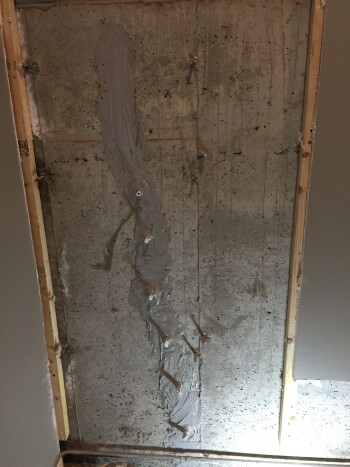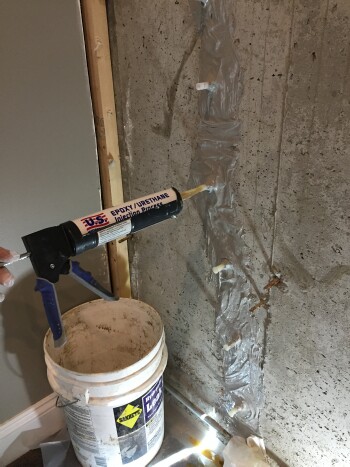Within a year or so of buying our house I noticed a 2 foot section of baseboard slightly discolored and swelling up in the basement. Few people would have even noticed it but I’m obsessive about water getting into the house and I knew that this was a sure sign of a basement water leak. Since I have a french drain and sump pump I figured there had to be some kind of crack or opening somewhere.
I knew what had to be done but I figured that as long as it was limited to that small section of baseboard I was going to live with it. So I kept an eye on it and checked it regularly with a moisture meter. It dried out in the winter and then registered wet again in the warmer weather.
But then one day I noticed the drywall starting to bubble up and decided that procrastination was not working for me. I knew it was time to open up the wall and find out what was going on. There is no way to avoid this, though I had tried. I had my $85/ hour handyman remove that section of baseboard and the affected drywall. No surprise…the insulation was moldy. In order to get rid of all the mold my handyman had to open up a 6 foot wide section at the bottom of the wall and a narrower 5 foot high section along the left side. Some framing and the baseboard had to be removed also. When we were done we could see a 3 foot long vertical, hairline crack in the concrete basement wall.
Then I called a waterproofing company. The first thing we did when their sales rep showed up was turn a water hose on right next to where the crack was – on the outside of the house, not the inside. It’s important to get that part right. Within a few minutes we could see water coming in through the crack. We walked around the house to see if there were any external signs of other cracks but, much to the dismay of the sales rep, there weren’t any.
The sales rep very politely tolerated my crack jokes, quoted me a price, and explained how they would fix the crack. I had called around and everyone’s prices were about the same, which smells of price fixing but then this is Chicago. I was able to get him down to $680 which I believe was about $100 below their list price. I’m curious to know if anyone has been able to get a cheaper price.
How They Fix Basement Wall Cracks
Note that this description of the process assumes poured concrete basement walls.
First we had to remove more drywall and framing up to a height slightly above grade just in case the crack went that high. Then a guy came out and epoxied some plastic “ports” along the crack and covered the rest of the crack with epoxy. See the photo on the right as to what the job looked like at that stage.
The ports are used to inject a urethane resin into the crack and the epoxy along the crack prevents the resin from oozing back in. The resin then travels along the crack and to the outside of the wall, totally filling it.
The photo on the left shows the waterproofing guy injecting the resin into the ports. The whole process took less than 2 hours, which is a damn good hourly rate – for them, not for us. Like a lot of businesses, including real estate, the customer pays for the customer acquisition cost.
After the repair dried my $85/ hour handyman came back out to put the wall back together and paint it. These waterproofing guys would have done the entire job including wall removal and reconstruction for two additional fees but I determined that it was a lot cheaper to have my guy do it. Plus, I wanted more control over the process.
#HomeMaintenance #Basements #HomeRepair #WaterLeaks
Gary Lucido is the President of Lucid Realty, the Chicago area’s full service real estate brokerage that offers home buyer rebates and discount commissions. If you want to keep up to date on the Chicago real estate market or get an insider’s view of the seamy underbelly of the real estate industry you can Subscribe to Getting Real by Email using the form below. Please be sure to verify your email address when you receive the verification notice.

